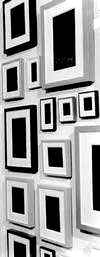THOMAS LAWSON
For several years now Allan McCollum has been building little model paintings. Each has a central plane painted a monochromatic black or brown; a mat, usually off-white, and a raised, framelike border in brown or tan. The works vary in size but all are small, none much larger than 16 or so inches high. They are generic paintings, and McCollum often hangs them together to make generic installations and exhibitions. His work has always been funny, with an oddly embarrassed, rather sardonic air. In this show it became almost savage in it's humor, tremendously aggressive, and yet surprisingly likable.
The show was McCollum's most ambitious to date, 553 plaster casts in 20 shapes and sizes, surrogates for painting with little in the way of individuating character. The installation was hilarious, the walls banked high with interchangeable little blanks, making the gallery look like some crazed stage set for an avant-garde play about the academy. Of all the ambitious shows of the season it was among the most successful, not simply because it made fun of the big picture, but because it pointed to the absurdity of the big show. McCollum's exhibition carried more visual punch than most of the big ego-inflating extravaganzas around town, his little non-images paradoxically more memorable than many of the large, over-imaged works that sought to overwhelm us with their importance.
Much of this sounds familiar by now, standard deconstructivist strategy akin to, say, the practice of Sherrie Levine. But the brilliance of McCollum's work is that it steps beyond this, advances or, rather, sophisticates the argument, demonstrating that the aura of the work of art supposedly lost through the act of mechanical reproduction can be recuperated through that same repetition. The art objects aura may be destroyed by the photograph, but that loss is more than compensated for by the additional aura invested in the image itself. Image becomes all, as the electronic media prove so well. Accordingly, McCollum divests himself of the image in order to recover the object. His pictures are blank, but in their blankness they assume the characteristics of the image, become images of a particular kind of image, of painting. And hundreds of them clustrered down the wall reaffirm the image of art. Strangely enough they discover, in the potentially endless repetition of the plaster cast, a reinvented aura of the art object, a contemporary aura, not that of a sacrosanct uniqueness but that of a communal guarantee of image recognition.
Mass reproduction has frozen our interest in the unique object or event; the unique seems suspect and unreal. We now seek meaning in rituals of partial identification, a kind of truth in labeling. In this sense the plaster casts reaffirm art as they appear to denigrate it, just as the more inflated expressionists denigrate art as they claim to save it. The paintings of the latter group seek to return art to the past, and so insure its impotence in the modern world. McCollum acknowledges the fragility of art, and in doing so produces these self-effacing mechanically-reproduced objects that can command our attention.

Allan McCollum.
Plaster Surrogates.
1982-83
Installation at
Marian Goodman,
New York City, 1983.
|

Allan McCollum.
Plaster Surrogates.
(detail) 1982-83
|